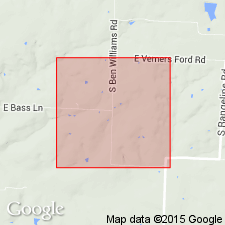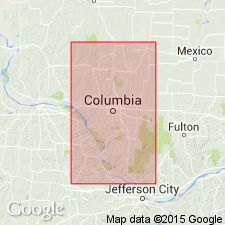
- Usage in publication:
-
- Ashland limestone
- Modifications:
-
- Original reference
- Dominant lithology:
-
- Limestone
- AAPG geologic province:
-
- Ozark uplift
Summary:
Pg. 81, 83, 85. Ashland limestone. Compact, fossiliferous limestone. Maximum thickness about 15 feet in type area, unconformably underlies Callaway limestone; unconformably overlies Jefferson City dolomite. Crops out in sec. 1, T. 47 N., R. 12 W. [Age is Middle Devonian.]
Source: US geologic names lexicon (USGS Bull. 1200, p. 151).

- Usage in publication:
-
- Ashland limestone†
- Ashland limestone facies (informal)
- Modifications:
-
- Abandoned
- AAPG geologic province:
-
- Ozark uplift
Summary:
Pg. 37-39. Term Ashland is preoccupied. Unit is herein referred to as Ashland limestone facies to denote RENSSELANDIA-bearing beds of Callaway formation. Type locality redesignated due to misprint in original description. Age is Middle Devonian.
Type locality: in NE/4 SW/4 sec. 1, T. 46 N., R. 12 W., Boone Co., northeastern MO, about 0.3 mi north of Sycamore School, along an old abandoned roadway, 9 mi north-northwest of Jefferson City. Type locality covers only about 10 acres. Named from village of Ashland.
Source: US geologic names lexicon (USGS Bull. 1200, p. 151).
For more information, please contact Nancy Stamm, Geologic Names Committee Secretary.
Asterisk (*) indicates published by U.S. Geological Survey authors.
"No current usage" (†) implies that a name has been abandoned or has fallen into disuse. Former usage and, if known, replacement name given in parentheses ( ).
Slash (/) indicates name conflicts with nomenclatural guidelines (CSN, 1933; ACSN, 1961, 1970; NACSN, 1983, 2005, 2021). May be explained within brackets ([ ]).

